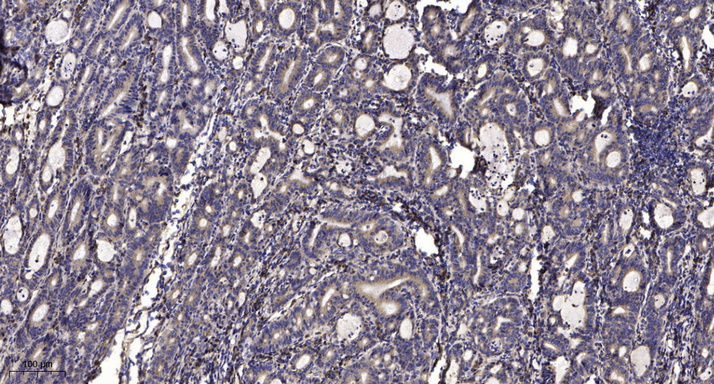CYP4V2 Polyclonal Antibody
- Catalog No.:YT1236
- Applications:WB;IHC;IF;ELISA
- Reactivity:Human;Rat;Mouse;
- Target:
- CYP4V2
- Gene Name:
- CYP4V2
- Protein Name:
- Cytochrome P450 4V2
- Human Gene Id:
- 285440
- Human Swiss Prot No:
- Q6ZWL3
- Mouse Swiss Prot No:
- Q9DBW0
- Immunogen:
- Synthesized peptide derived from the Internal region of human CYP4V2.
- Specificity:
- CYP4V2 Polyclonal Antibody detects endogenous levels of CYP4V2 protein.
- Formulation:
- Liquid in PBS containing 50% glycerol, 0.5% BSA and 0.02% sodium azide.
- Source:
- Polyclonal, Rabbit,IgG
- Dilution:
- WB 1:500 - 1:2000. IHC 1:100 - 1:300. ELISA: 1:20000.. IF 1:50-200
- Purification:
- The antibody was affinity-purified from rabbit antiserum by affinity-chromatography using epitope-specific immunogen.
- Concentration:
- 1 mg/ml
- Storage Stability:
- -15°C to -25°C/1 year(Do not lower than -25°C)
- Other Name:
- CYP4V2;Cytochrome P450 4V2
- Observed Band(KD):
- 60kD
- Background:
- This gene encodes a member of the cytochrome P450 hemethiolate protein superfamily which are involved in oxidizing various substrates in the metabolic pathway. It is implicated in the metabolism of fatty acid precursors into n-3 polyunsaturated fatty acids. Mutations in this gene result in Bietti crystalline corneoretinal dystrophy. [provided by RefSeq, Jul 2008],
- Function:
- cofactor:Heme group.,disease:Defects in CYP4V2 are a cause of Bietti crystalline corneoretinal dystrophy (BCD) [MIM:210370]. BCD is an autosomal recessive retinal dystrophy characterized by multiple glistening intraretinal crystals scattered over the fundus, a characteristic degeneration of the retina, and sclerosis of the choroidal vessels, ultimately resulting in progressive night blindness and constriction of the visual field. Most cases have similar crystals at the corneoscleral limbus. Clinically, BCD is progressive. Patients develop decreased vision, nyctalopia, and paracentral scotomata between the 2nd and 4th decade of life. Later, patients develop peripheral visual field loss and marked visual impairment, usually progressing to legal blindness by the 5th or 6th decade of life.,function:Unknown. May have a role in fatty acid and steroid metabolism.,similarity:Belongs to the cytoc
- Subcellular Location:
- Endoplasmic reticulum membrane ; Single-pass membrane protein .
- Expression:
- Broadly expressed. Detected in heart, brain, placenta, lung, liver, skeletal muscle, kidney, pancreas, retina, retinal pigment epithelium (RPE) and lymphocytes.
- June 19-2018
- WESTERN IMMUNOBLOTTING PROTOCOL
- June 19-2018
- IMMUNOHISTOCHEMISTRY-PARAFFIN PROTOCOL
- June 19-2018
- IMMUNOFLUORESCENCE PROTOCOL
- September 08-2020
- FLOW-CYTOMEYRT-PROTOCOL
- May 20-2022
- Cell-Based ELISA│解您多样本WB检测之困扰
- July 13-2018
- CELL-BASED-ELISA-PROTOCOL-FOR-ACETYL-PROTEIN
- July 13-2018
- CELL-BASED-ELISA-PROTOCOL-FOR-PHOSPHO-PROTEIN
- July 13-2018
- Antibody-FAQs
- Products Images

- Immunohistochemical analysis of paraffin-embedded human Gastric adenocarcinoma. 1, Antibody was diluted at 1:200(4° overnight). 2, Tris-EDTA,pH9.0 was used for antigen retrieval. 3,Secondary antibody was diluted at 1:200(room temperature, 45min).



